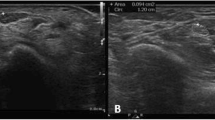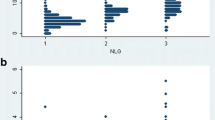Abstract
Purpose
The purpose of the study was to examine the most adequate cut-off point for median nerve cross-sectional area and additional ultrasound features supporting the diagnosis of carpal tunnel syndrome (CTS).
Material and methods
Forty wrists from 31 CTS patients and 63 wrists from 37 asymptomatic volunteers were evaluated by ultrasound. All patients were women. The mean age was 49.1 years (range: 29–78) in the symptomatic and 45.1 years (range 24–82) in the asymptomatic group. Median nerve cross-sectional area was obtained using direct (DT) and indirect (IT) techniques. Median nerve echogenicity, mobility, flexor retinaculum measurement and the anteroposterior (AP) carpal tunnel distance were assessed. This study was IRB-approved and all patients gave informed consent prior to examination.
Results
In CTS the median nerve cross-sectional area was increased compared with the control group. Median nerve cross-sectional area of 10 mm2 (DT) and 9 mm2 (IT) had high sensitivity (85% and 88.5%, respectively), specificity (92.1% and 82.5%) and accuracy (89.3% and 82.5%) in the diagnosis of CTS. CTS patients had an increased carpal tunnel AP diameter, flexor retinaculum thickening, reduced median nerve mobility and decreased median nerve echogenicity.
Conclusion
Ultrasound assists in the diagnosis of CTS using the median nerve diameter cut-off point of 10 mm2 (DT) and 9 mm2 (IT) and several additional findings.





Similar content being viewed by others
References
Phalen GS. The carpal-tunnel syndrome. Clinical evaluation of 598 hands. Clin Orthop Relat Res 1972; 83: 29–40.
Lee D, van Holsbeeck MT, Janevski PK, Ganos DL, Ditmars DM, Darian VB. Diagnosis of carpal tunnel syndrome. Ultrasound versus electromyography. Radiol Clin North Am 1999; 37: 859–872.
Wiesler ER, Chloros GD, Cartwright MS, Smith BP, Rushing J, Walker FO. The use of diagnostic ultrasound in carpal tunnel syndrome. J Hand Surg [Am] 2006; 31: 726–732.
Duncan I, Sullivan P, Lomas F. Sonography in the diagnosis of carpal tunnel syndrome. AJR Am J Roentgenol 1999; 173: 681–684.
Buchberger W, Schon G, Strasser K, Jungwirth W. High-resolution ultrasonography of the carpal tunnel. J Ultrasound Med 1991; 10: 531–537.
Koyuncuoglu HR, Kutluhan S, Yesildag A, Oyar O, Guler K, Ozden A. The value of ultrasonographic measurement in carpal tunnel syndrome in patients with negative electrodiagnostic tests. Eur J Radiol 2005; 56: 365–369.
Beekman R, Visser LH. High-resolution sonography of the peripheral nervous system—a review of the literature. Eur J Neurol 2004; 11: 305–314.
Silvestri E, Martinoli C, Derchi LE, Bertolotto M, Chiaramondia M, Rosenberg I. Echotexture of peripheral nerves: correlation between US and histologic findings and criteria to differentiate tendons. Radiology 1995; 197: 291–296.
Buchberger W, Judmaier W, Birbamer G, Lener M, Schmidauer C. Carpal tunnel syndrome: diagnosis with high-resolution sonography. AJR Am J Roentgenol 1992; 159: 793–798.
Wong SM, Griffith JF, Hui AC, Lo SK, Fu M, Wong KS. Carpal tunnel syndrome: diagnostic usefulness of sonography. Radiology 2004; 232: 93–99.
Ziswiler HR, Reichenbach S, Vogelin E, Bachmann LM, Villiger PM, Juni P. Diagnostic value of sonography in patients with suspected carpal tunnel syndrome: a prospective study. Arthritis Rheum 2005; 52: 304–311.
Yesildag A, Kutluhan S, Sengul N, et al. The role of ultrasonographic measurements of the median nerve in the diagnosis of carpal tunnel syndrome. Clin Radiol 2004; 59: 910–915.
Kamolz LP, Schrogendorfer KF, Rab M, Girsch W, Gruber H, Frey M. The precision of ultrasound imaging and its relevance for carpal tunnel syndrome. Surg Radiol Anat 2001; 23: 117–121.
Sarria L, Cabada T, Cozcolluela R, Martinez-Berganza T, Garcia S. Carpal tunnel syndrome: usefulness of sonography. Eur Radiol 2000; 10: 1920–1925.
Chen P, Maklad N, Redwine M, Zelitt D. Dynamic high-resolution sonography of the carpal tunnel. AJR Am J Roentgenol 1997; 168: 533–537.
Kele H, Verheggen R, Bittermann HJ, Reimers CD. The potential value of ultrasonography in the evaluation of carpal tunnel syndrome. Neurology 2003; 61: 389–391.
Beekman R, Visser LH. Sonography in the diagnosis of carpal tunnel syndrome: a critical review of the literature. Muscle Nerve 2003; 27: 26–33.
Buchberger W. Radiologic imaging of the carpal tunnel. Eur J Radiol 1997; 25: 112–117.
Nakamichi K, Tachibana S. Restricted motion of the median nerve in carpal tunnel syndrome. J Hand Surg [Br] 1995; 20: 460–464.
Author information
Authors and Affiliations
Corresponding author
Rights and permissions
About this article
Cite this article
Sernik, R.A., Abicalaf, C.A., Pimentel, B.F. et al. Ultrasound features of carpal tunnel syndrome: a prospective case-control study. Skeletal Radiol 37, 49–53 (2008). https://doi.org/10.1007/s00256-007-0372-9
Received:
Revised:
Accepted:
Published:
Issue Date:
DOI: https://doi.org/10.1007/s00256-007-0372-9




